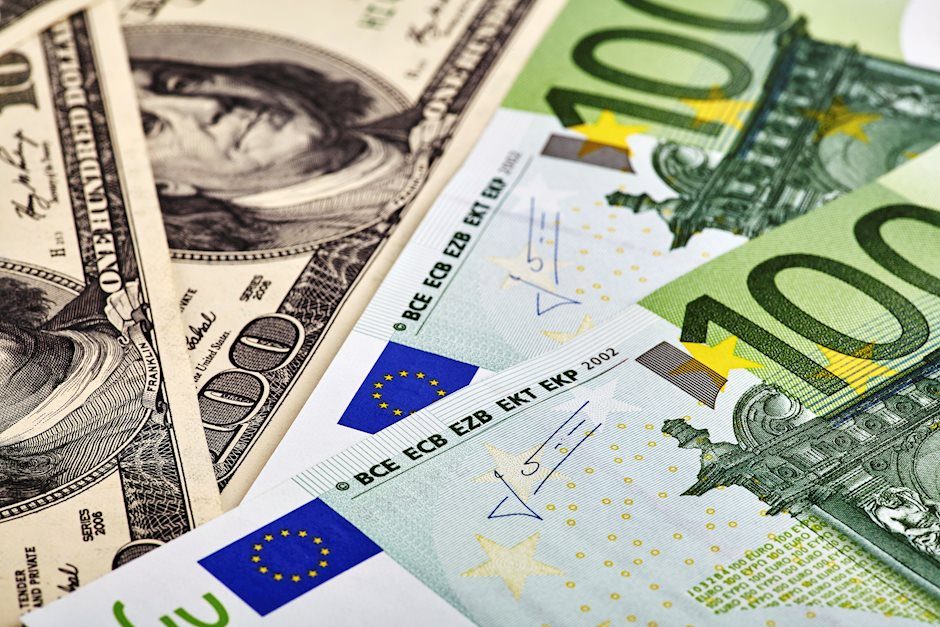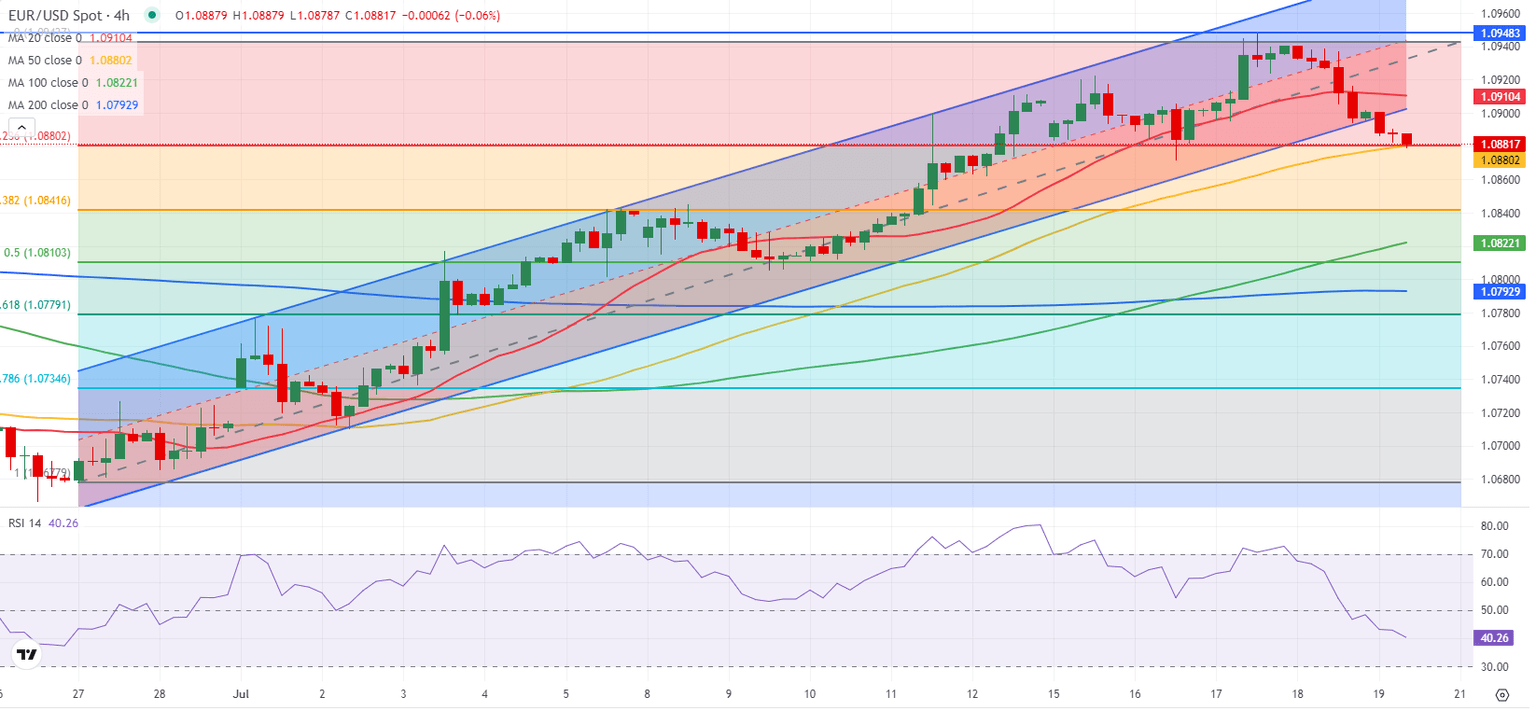EUR/USD Forecast: Euro turns bearish following ECB event
- EUR/USD trades below 1.0900 after closing in negative territory on Thursday.
- Dovish comments from ECB officials weigh on the Euro early Friday.
- The souring market mood could make it difficult for the pair to regain its traction.

EUR/USD came under bearish pressure in the second half of the day on Thursday and closed in negative territory, snapping a six-day winning streak. The pair stays on the back foot and trades below 1.0900 early Friday, while the technical outlook points to a buildup of bearish momentum.
Euro PRICE This week
The table below shows the percentage change of Euro (EUR) against listed major currencies this week. Euro was the weakest against the Swiss Franc.
| USD | EUR | GBP | JPY | CAD | AUD | NZD | CHF | |
|---|---|---|---|---|---|---|---|---|
| USD | 0.23% | 0.47% | -0.61% | 0.52% | 1.37% | 1.35% | -0.67% | |
| EUR | -0.23% | 0.28% | -0.62% | 0.49% | 1.17% | 1.32% | -0.71% | |
| GBP | -0.47% | -0.28% | -0.55% | 0.21% | 0.90% | 0.99% | -0.98% | |
| JPY | 0.61% | 0.62% | 0.55% | 1.12% | 1.76% | 1.92% | -0.26% | |
| CAD | -0.52% | -0.49% | -0.21% | -1.12% | 0.77% | 0.83% | -1.20% | |
| AUD | -1.37% | -1.17% | -0.90% | -1.76% | -0.77% | 0.14% | -1.86% | |
| NZD | -1.35% | -1.32% | -0.99% | -1.92% | -0.83% | -0.14% | -2.01% | |
| CHF | 0.67% | 0.71% | 0.98% | 0.26% | 1.20% | 1.86% | 2.01% |
The heat map shows percentage changes of major currencies against each other. The base currency is picked from the left column, while the quote currency is picked from the top row. For example, if you pick the Euro from the left column and move along the horizontal line to the US Dollar, the percentage change displayed in the box will represent EUR (base)/USD (quote).
The European Central Bank (ECB) left monetary policy settings unchanged following the July policy meeting, as widely expected. In the post-meeting press conference, ECB President Christine Lagarde noted that risks to growth are tilted to the downside and reiterated the data dependent approach to policy, saying September decision is "wide open."
The risk-averse market atmosphere and Lagarde's vague comments on policy outlook triggered a decline in EUR/USD during the American trading hours on Thursday.
Early Friday, ECB Governing Council member and Bank of France President, Francois Villeroy de Galhau, said there is more uncertainty on growth than a few months ago and added that market expectations on ECB rate outlook was reasonable. Similarly, ECB Governing Council member Gediminas Šimkus said that he was in agreement with markets, which are forecasting two more 25 basis points rate cuts this year.
The US economic docket will not feature any high-impact macroeconomic data releases on Friday. In case safe-haven flows continue to dominate financial markets, the USD could preserve its strength heading into the weekend and cause EUR/USD to stretch lower.
EUR/USD Technical Analysis
The Relative Strength Index (RSI) indicator on the 4-hour chart dropped below 50 for the first time since late June and EUR/USD closed the last two 4-hour candles below the lower limit of the ascending regression channel, pointing to a bearish shift in the near-term outlook.
On the downside, 1.0880 (Fibonacci 23.6% retracement of the latest uptrend) aligns as immediate support. If EUR/USD starts using this level as resistance, 1.0840 (Fibonacci 38.2% retracement) could be seen as next support before 1.0820 (100-period Simple Moving Average).
1.0900 (psychological level, static level) could be seen as first resistance on the upside ahead of 1.0950 (static level) and 1.1000 (psychological level, static level).
Euro FAQs
The Euro is the currency for the 20 European Union countries that belong to the Eurozone. It is the second most heavily traded currency in the world behind the US Dollar. In 2022, it accounted for 31% of all foreign exchange transactions, with an average daily turnover of over $2.2 trillion a day. EUR/USD is the most heavily traded currency pair in the world, accounting for an estimated 30% off all transactions, followed by EUR/JPY (4%), EUR/GBP (3%) and EUR/AUD (2%).
The European Central Bank (ECB) in Frankfurt, Germany, is the reserve bank for the Eurozone. The ECB sets interest rates and manages monetary policy. The ECB’s primary mandate is to maintain price stability, which means either controlling inflation or stimulating growth. Its primary tool is the raising or lowering of interest rates. Relatively high interest rates – or the expectation of higher rates – will usually benefit the Euro and vice versa. The ECB Governing Council makes monetary policy decisions at meetings held eight times a year. Decisions are made by heads of the Eurozone national banks and six permanent members, including the President of the ECB, Christine Lagarde.
Eurozone inflation data, measured by the Harmonized Index of Consumer Prices (HICP), is an important econometric for the Euro. If inflation rises more than expected, especially if above the ECB’s 2% target, it obliges the ECB to raise interest rates to bring it back under control. Relatively high interest rates compared to its counterparts will usually benefit the Euro, as it makes the region more attractive as a place for global investors to park their money.
Data releases gauge the health of the economy and can impact on the Euro. Indicators such as GDP, Manufacturing and Services PMIs, employment, and consumer sentiment surveys can all influence the direction of the single currency. A strong economy is good for the Euro. Not only does it attract more foreign investment but it may encourage the ECB to put up interest rates, which will directly strengthen the Euro. Otherwise, if economic data is weak, the Euro is likely to fall. Economic data for the four largest economies in the euro area (Germany, France, Italy and Spain) are especially significant, as they account for 75% of the Eurozone’s economy.
Another significant data release for the Euro is the Trade Balance. This indicator measures the difference between what a country earns from its exports and what it spends on imports over a given period. If a country produces highly sought after exports then its currency will gain in value purely from the extra demand created from foreign buyers seeking to purchase these goods. Therefore, a positive net Trade Balance strengthens a currency and vice versa for a negative balance.
Premium
You have reached your limit of 3 free articles for this month.
Start your subscription and get access to all our original articles.
Author

Eren Sengezer
FXStreet
As an economist at heart, Eren Sengezer specializes in the assessment of the short-term and long-term impacts of macroeconomic data, central bank policies and political developments on financial assets.


















